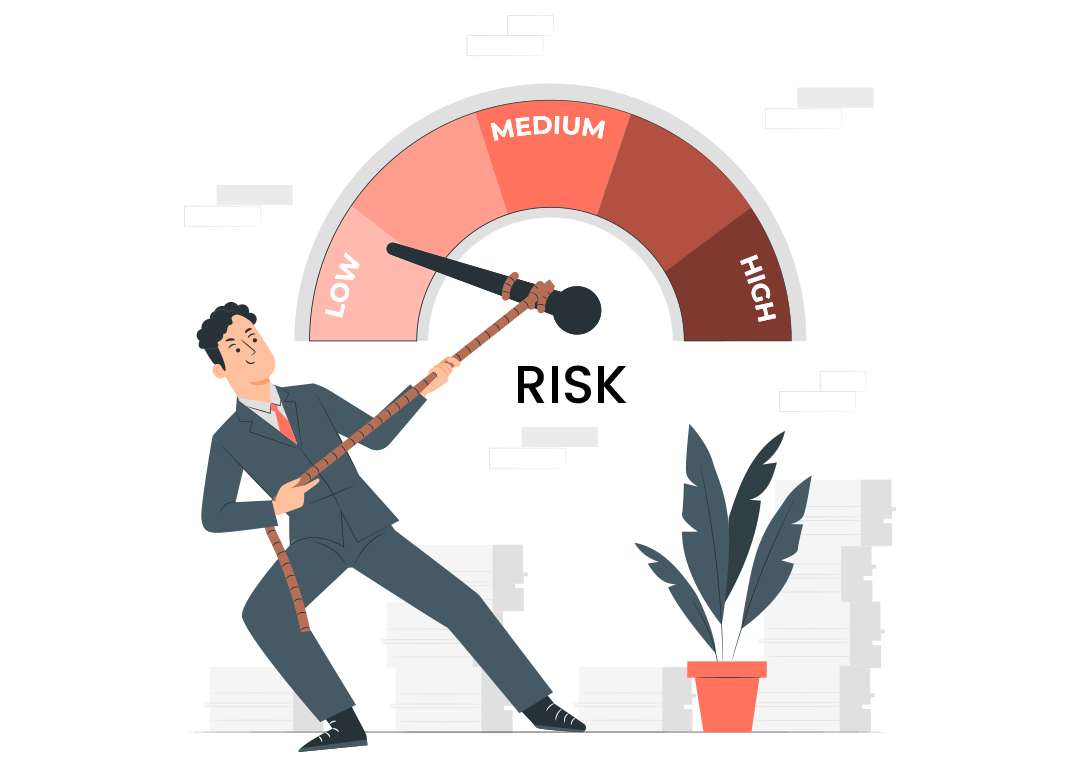How To Reduce Risk?
Biggest risk in Stock Market?
Lose money.
Why do we lose money?
- Short-term orientation: Make impulsive decisions based on market fluctuations
- Emotions of fear and greed: Make irrational decisions, for ex- panic selling
- Rich quick mindset: Invest in speculative stocks without conducting research
- Wrong stocks: Invest in overvalued or have poor fundamentals
- Wrong timing: Sell in recession, buy at the peak
How to reduce risk?

When attempting to reduce risk in the stock market, there are two primary methods to consider:
- Decrease the likelihood of experiencing losses
- Limit the amount of monetary loss in the event of a loss
Here are several strategies to help achieve these objectives:
Diversification: By spreading your investments across multiple asset classes, sectors, and geographical locations, you can minimize the impact of losses in one particular area or sector.
For example: Diversifying in index funds, mutual funds, ETFs, etc., can reduce the exposure to numerous risks in the market. You can also consider investing in low-risk securities, such as bonds or Treasury bills, as a part of your portfolio.
Avoid Market Timing: Trying to time the market by buying and selling based on short-term price movements is risky. Instead, focus on time in the market with long-term investment plans.
Dollar-cost averaging: or Systematic Asset Allocation. It is one of the most successful strategies for creating long-term wealth, which requires consistency and discipline. This involves investing a fixed amount of money regularly.
For example, investing X amount of money monthly regardless of the everyday market conditions.
Due your research: You must do due diligence based on your investment goals and age. You can also consider a professional financial advisor who can help you assess your risk tolerance and create a diversified portfolio that fits your objectives.
Setting Realistic Expectations: Although you may receive some income from dividends and capital gains. But investing in the stock market is not a career that typically generates income in the early stages of investment. It is uncommon for individuals to make a living solely through full-time investing unless they are a trader. It is crucial to focus on growing the capital you have rather than relying on immediate 10X returns.
The margin of safety: The idea behind the margin of safety strategy is that if you buy a stock at a significant discount to its intrinsic value, you will have a built-in cushion that can allow you to make mistakes in your analysis and still make money.
Key Takeaways
It is impossible to eliminate risk entirely in any type of investment, you can only reduce it by making wise decisions. Stock market investing is a way to grow your wealth over the long term, but it’s important to have realistic expectations, a solid financial foundation, and a diversified investment strategy.

What to do when emotions trigger?
These are great rules for managing emotions as an investor. Let me summarize them:

Stick to the company’s fundamentals: Focus on the company’s underlying financial and operational performance rather than being convinced by short-term market fluctuations. Remind yourself why you invested in the company.
Maintain discipline: Stay calm and follow your plan, even during market turbulence. Patience and persistence can pay off in the long run.
Create Systems: Regularly investing will help you to contribute a set amount of money which can help you smooth out market volatility and potentially increase your returns.
Focus on Intrinsic Value: Focusing on intrinsic value can help investors make more rational investment decisions, and avoid overreacting to market fluctuations.
Key Takeaway
When the market falls, don’t sell your investments.
Biggest risk in Stock Market?
Lose money.
Why do we lose money?
- Short-term orientation: Make impulsive decisions based on market fluctuations
- Emotions of fear and greed: Make irrational decisions, for ex- panic selling
- Rich quick mindset: Invest in speculative stocks without conducting research
- Wrong stocks: Invest in overvalued or have poor fundamentals
- Wrong timing: Sell in recession, buy at the peak
How to reduce risk?

When attempting to reduce risk in the stock market, there are two primary methods to consider:
- Decrease the likelihood of experiencing losses
- Limit the amount of monetary loss in the event of a loss
Here are several strategies to help achieve these objectives:
Diversification: By spreading your investments across multiple asset classes, sectors, and geographical locations, you can minimize the impact of losses in one particular area or sector.
For example: Diversifying in index funds, mutual funds, ETFs, etc., can reduce the exposure to numerous risks in the market. You can also consider investing in low-risk securities, such as bonds or Treasury bills, as a part of your portfolio.
Avoid Market Timing: Trying to time the market by buying and selling based on short-term price movements is risky. Instead, focus on time in the market with long-term investment plans.
Dollar-cost averaging: or Systematic Asset Allocation. It is one of the most successful strategies for creating long-term wealth, which requires consistency and discipline. This involves investing a fixed amount of money regularly.
For example, investing X amount of money monthly regardless of the everyday market conditions.
Due your research: You must do due diligence based on your investment goals and age. You can also consider a professional financial advisor who can help you assess your risk tolerance and create a diversified portfolio that fits your objectives.
Setting Realistic Expectations: Although you may receive some income from dividends and capital gains. But investing in the stock market is not a career that typically generates income in the early stages of investment. It is uncommon for individuals to make a living solely through full-time investing unless they are a trader. It is crucial to focus on growing the capital you have rather than relying on immediate 10X returns.
The margin of safety: The idea behind the margin of safety strategy is that if you buy a stock at a significant discount to its intrinsic value, you will have a built-in cushion that can allow you to make mistakes in your analysis and still make money.
Key Takeaways
It is impossible to eliminate risk entirely in any type of investment, you can only reduce it by making wise decisions. Stock market investing is a way to grow your wealth over the long term, but it’s important to have realistic expectations, a solid financial foundation, and a diversified investment strategy.

What to do when emotions trigger?
These are great rules for managing emotions as an investor. Let me summarize them:

Stick to the company’s fundamentals: Focus on the company’s underlying financial and operational performance rather than being convinced by short-term market fluctuations. Remind yourself why you invested in the company.
Maintain discipline: Stay calm and follow your plan, even during market turbulence. Patience and persistence can pay off in the long run.
Create Systems: Regularly investing will help you to contribute a set amount of money which can help you smooth out market volatility and potentially increase your returns.
Focus on Intrinsic Value: Focusing on intrinsic value can help investors make more rational investment decisions, and avoid overreacting to market fluctuations.
Key Takeaway
When the market falls, don’t sell your investments.
